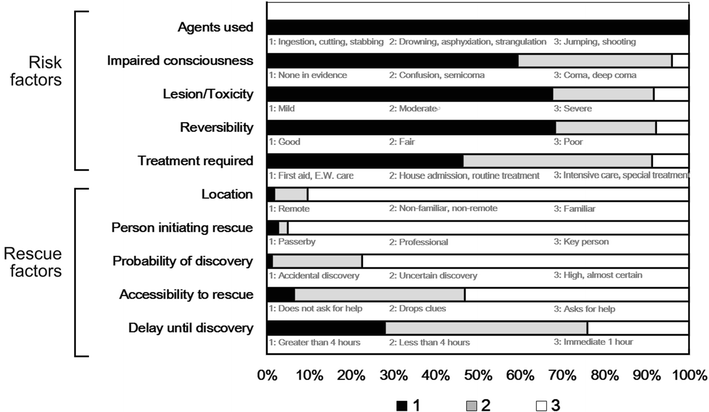Which deliberate self-poisoning patients are most likely to make high-lethality suicide attempts?
- PMID: 26347801
- PMCID: PMC4561421
- DOI: 10.1186/s13033-015-0028-4
Which deliberate self-poisoning patients are most likely to make high-lethality suicide attempts?
Abstract
Background: The risk/rescue rating scale (RRRS) assesses the lethality of a suicide attempt, which is defined as the probability of inflicting irreversible damage. We assessed the lethality of suicide attempts using the RRRS and identified the socio-demographic profiles of patients who achieved high lethality in deliberate self-poisoning (DSP).
Methods: A retrospective study was conducted to evaluate DSP patients who visited the emergency department of a tertiary teaching hospital between 2000 and 2011. The data included socio-demographic information, clinical variables, risk factors (e.g., the method used, whether consciousness was impaired, toxicity, reversibility and whether treatment was required) and rescue factors (e.g., location, who initiated the rescue, the probability of discovery, the accessibility of rescue, and delay until discovery). The high-risk group consisted of patients with 11-15 risk points, whereas patients in the low-rescue group had 5-11 risk points. We examined the characteristics of high-lethality suicide attempts (high-risk/low-rescue group).
Results: A total of 1114 patients were enrolled in this study. Pearson's correlation analysis showed that the total risk score for patients with DSP was negatively associated with the total rescue score (r = -0.201, p < 0.001). Of the total number of DSP patients, 42 were included in the high-risk/low-rescue group. The multivariate logistic regression analyses showed significant associations between high-lethality suicide attempts and male gender (OR 2.70, 95 % CI 1.41-5.18, p = 0.003), older age (OR 1.02, 95 % CI 1.01-1.04, p = 0.015), and unemployment (OR 2.98, 95 % CI 1.41-6.33, p = 0.004).
Conclusion: This retrospective study demonstrates that male gender, advanced age, and unemployed status were associated with high-lethality suicide attempts in DSP patients.
Keywords: Deliberate self-poisoning; Rescue factors; Risk factors; Suicide attempts.
Figures
Similar articles
-
Association of the COVID-19 Pandemic and Low-rescue Suicide Attempts in Patients Visiting the Emergency Department after Attempting Suicide.J Korean Med Sci. 2021 Aug 30;36(34):e243. doi: 10.3346/jkms.2021.36.e243. J Korean Med Sci. 2021. PMID: 34463065 Free PMC article.
-
Lethality-Associated Factors in Deliberate Self-Poisoning.Soa Chongsonyon Chongsin Uihak. 2021 Jan 1;32(1):17-27. doi: 10.5765/jkacap.200034. Soa Chongsonyon Chongsin Uihak. 2021. PMID: 33424238 Free PMC article.
-
Patients admitted to hospital after suicide attempt with violent methods compared to patients with deliberate self-poisoning -a study of background variables, somatic and psychiatric health and suicidal behavior.BMC Psychiatry. 2018 Jan 24;18(1):21. doi: 10.1186/s12888-018-1602-5. BMC Psychiatry. 2018. PMID: 29368645 Free PMC article.
-
Deliberate self-poisoning: factors associated with recurrent self-poisoning.Am J Emerg Med. 2011 Oct;29(8):908-12. doi: 10.1016/j.ajem.2011.03.015. Am J Emerg Med. 2011. PMID: 21641159
-
Analysis of Deliberate Self-Wrist-Cutting Episodes Presenting to the Emergency Department.Crisis. 2016 Mar;37(2):155-60. doi: 10.1027/0227-5910/a000361. Epub 2015 Dec 23. Crisis. 2016. PMID: 26695871
Cited by
-
Testing the psychometric properties of the risk-rescue rating scale: a lethality measure for suicide attempts.Int J Ment Health Syst. 2025 Jan 30;19(1):5. doi: 10.1186/s13033-025-00662-0. Int J Ment Health Syst. 2025. PMID: 39885553 Free PMC article.
-
Predictive factors for the medical hospitalisation of patients who visited the emergency department with suicide attempt.BMC Psychiatry. 2021 Feb 6;21(1):79. doi: 10.1186/s12888-021-03089-2. BMC Psychiatry. 2021. PMID: 33549077 Free PMC article.
-
Poisoning Severity Associated with a Range of Medications in Suicide Attempts by Ingestion.Suicide Life Threat Behav. 2019 Jun;49(3):635-642. doi: 10.1111/sltb.12468. Epub 2018 Apr 25. Suicide Life Threat Behav. 2019. PMID: 29693268 Free PMC article.
-
Association of the COVID-19 Pandemic and Low-rescue Suicide Attempts in Patients Visiting the Emergency Department after Attempting Suicide.J Korean Med Sci. 2021 Aug 30;36(34):e243. doi: 10.3346/jkms.2021.36.e243. J Korean Med Sci. 2021. PMID: 34463065 Free PMC article.
-
Instability of emotional relationships and suicide among youth: a qualitative study.BMC Psychiatry. 2023 Jan 18;23(1):50. doi: 10.1186/s12888-023-04534-0. BMC Psychiatry. 2023. PMID: 36653769 Free PMC article.
References
-
- Statistics Korea. Annual report on the cause of death statistics. 2011. http://www.kostat.go.kr/portal/korea/index.action. Accessed June 3 2013.
-
- Diekstra RF, Gulbinat W. The epidemiology of suicidal behaviour: a review of three continents. World Health Stat Q. 1993;46:52–68. - PubMed
LinkOut - more resources
Full Text Sources
Other Literature Sources
Miscellaneous



